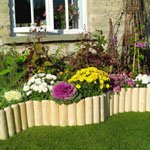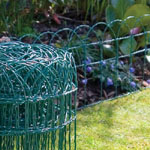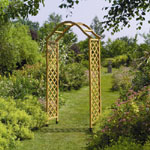
01757 28907301757 289073

York Garden Centre - No Retail Outlet Bowlands House, Ellerton, York, United Kingdom,
Garden of Interest
Garden Visit to Butchart Gardens
Here’s a distant one, but definitely worth a visit if you should ever be in Vancouver, Canada.
The garden is about 10 miles north of Victoria, the biggest town on the island and indeed the capital of British Colombia state and is situated on Saanich Sound, a sheltered Pacific inlet. The garden was created by Jennie Butchart in an old quarry, her husband, Robert, assisted by lending workers from his cement factory to do the heavy work.
The undoubted highlight of your visit will be the stunning view you get over the quarry before you descend to wander round the beds and the rock mountain, which you can climb to get a more localised view. The planting in these beds is as spectacular as you will see anywhere, with large swathes of strong colour, all of which seem to work really well together.
Further on there are lakes with fountains (up to 70 ft high), a rose garden and a very inspiring Japanese Garden, at the far end of which is a wonderful view of Butchart Cove leading out to Saanich Sound.
As you return you will pass a star shaped pond, and hence through the Italian Garden before you finish up in the Piazza and commercialism! The garden is always crowded with visitors so the commercial activities here will easily raise the vast amount of money needed to keep such a jewel of a garden in the near perfect condition you will find.
Gardens to Visit
Visit to Fast Rabbit Farm
Now here is a very different garden, and very definitely one you should visit , not manicured and not commercialised. It is the best haven for wildlife you will ever see and epitomises working with nature and not against it.
Fast Rabbit is 42 acres of the Strawberry Valley, near Dartmouth in Devon. It is the vision of one man, Phillip Mort, who, as well as having a day job, has created this 42 acre sanctuary. In season the garden comes explosively to life, with celandines, daffodils, bluebells, rhododendrons and a massive variety of acid-loving shrubs.
There are two distinct parts to the garden, that which is currently being developed, and that which has matured. We walked the paths of the embryo part first, along terraces cut out of the steep hillside, you walk alongside young rhododendrons, camellias and many other shrubs, some of which in late June were hard to see amid the growing grass and wild flowers. There are patches of manicured garden which come as a significant contrast to the wider plantings, and we encountered the owner planting up a magnificent series of steps which cut across the terraces on one side of the valley.
From here we made our way in the established part, which was planted up some 20-30 years ago. Here the trees and shrubs are bigger, but still surrounded by long grass and wild flowers. Only the paths are mown or strimmed on a regular basis, the areas between the shrubs and trees gets strimmed during the winter, so I guess if you visit by May the garden will seem more manicured than it does later in the year. The day we visited there was a constant drizzle, which accounted for the fact we saw few other visitors, and the whole area took on the aura of a lost garden which we were the only people to have discovered, magical to say the least.
The highlight of the garden was the large lake, with a Californian Swamp Cypress on the island, and a mass of cornus kousa, deutzia, and other flowering shrubs crowding in on the path.
As I said at the beginning this is a very different garden and one which you really should see, it is without doubt the garden I would most like to re-visit.
Visit to Rosemoor on our way to our destination on Dartmoor.
Rosewood is just outside Torrington on the Hartland peninsula in northeast Devon. It is a recent addition to the gardens, having opened in 1990 and consists of two very distinct parts, separated by the A3124. The older part was originally the garden of Lady Ann Palmer from 1931, and she developed the existing gardens to a fair approximation of what they are today, using the Spanish Maquis as her main inspiration. The newer part on the other side of the road is more typical of RHS gardens, being a series of rooms with different themes.
Specialist areas include two very well stocked rose gardens, a spiral garden, a hot garden (hot by colour reds, blacks, oranges etc) and a vegetable and fruit garden. All are very well laid out, and now, in late June, absolutely at their best. I am delighted to say, after my disappointment at Ness, that plant labelling is the most comprehensive I have ever seen consequently we have a lot of new plants to investigate and add to our own garden if suitable.
In Lady Ann’s garden there is less formality but the layout is equally good. In many cases one moves from area to area without any formal boundaries. Especially worth seeing here are the main lawn with its associated beds, and the stone garden where there are a number of planters, statues and artifacts.
All in all we thought Rosemoor to be well worth a visit and the obligatory tea rooms and plant sales up to standard and pretty much what you would expect.
Painswick Rococo Gardens
The term Rococo refers to a style of art in the 18th century which started as a rebellion against the strictly proscribed Baroque movement which preceded it. It is a more stylised, frivolous and decorative. In garden terms this becomes a garden which is more like a film set in which to have decadent parties, typified by buildings of slightly bizarre architecture.
Painswick is in the Cotswolds 4 miles north of Stroud and about 5 miles south of Gloucester.
Apart from the interesting and quirky buildings around the place, the gardens are renowned for their snowdrops which are a magnificent display in February. Other early spring flowers follow on, the hellebores and daffodils being particularly notable.
In keeping with the original philosophy of the garden, there are a number of planned events during the year. For instance at the moment there is a exhibition of mosaic sculpture by Victoria Harrison and on July 6th the Handel Bards, an eccentric band of travelling actors will present their version of Hamlet.
I love this garden because I like the way it shows off the flippant architecture in a garden setting, and I think this juxtaposition of architecture and planting is one of the most important aspects of garden design and it is done here like absolutely nowhere else!
Now here is a very different garden, and very definitely one you should visit , not manicured and not commercialised. It is the best haven for wildlife you will ever see and epitomises working with nature and not against it.
Fast Rabbit is 42 acres of the Strawberry Valley, near Dartmouth in Devon. It is the vision of one man, Phillip Mort, who, as well as having a day job, has created this 42 acre sanctuary. In season the garden comes explosively to life, with celandines, daffodils, bluebells, rhododendrons and a massive variety of acid-loving shrubs.
There are two distinct parts to the garden, that which is currently being developed, and that which has matured. We walked the paths of the embryo part first, along terraces cut out of the steep hillside, you walk alongside young rhododendrons, camellias and many other shrubs, some of which in late June were hard to see amid the growing grass and wild flowers. There are patches of manicured garden which come as a significant contrast to the wider plantings, and we encountered the owner planting up a magnificent series of steps which cut across the terraces on one side of the valley.
From here we made our way in the established part, which was planted up some 20-30 years ago. Here the trees and shrubs are bigger, but still surrounded by long grass and wild flowers. Only the paths are mown or strimmed on a regular basis, the areas between the shrubs and trees gets strimmed during the winter, so I guess if you visit by May the garden will seem more manicured than it does later in the year. The day we visited there was a constant drizzle, which accounted for the fact we saw few other visitors, and the whole area took on the aura of a lost garden which we were the only people to have discovered, magical to say the least.
The highlight of the garden was the large lake, with a Californian Swamp Cypress on the island, and a mass of cornus kousa, deutzia, and other flowering shrubs crowding in on the path.
As I said at the beginning this is a very different garden and one which you really should see, it is without doubt the garden I would most like to re-visit.
Visit to Rosemoor on our way to our destination on Dartmoor.
Rosewood is just outside Torrington on the Hartland peninsula in northeast Devon. It is a recent addition to the gardens, having opened in 1990 and consists of two very distinct parts, separated by the A3124. The older part was originally the garden of Lady Ann Palmer from 1931, and she developed the existing gardens to a fair approximation of what they are today, using the Spanish Maquis as her main inspiration. The newer part on the other side of the road is more typical of RHS gardens, being a series of rooms with different themes.
Specialist areas include two very well stocked rose gardens, a spiral garden, a hot garden (hot by colour reds, blacks, oranges etc) and a vegetable and fruit garden. All are very well laid out, and now, in late June, absolutely at their best. I am delighted to say, after my disappointment at Ness, that plant labelling is the most comprehensive I have ever seen consequently we have a lot of new plants to investigate and add to our own garden if suitable.
In Lady Ann’s garden there is less formality but the layout is equally good. In many cases one moves from area to area without any formal boundaries. Especially worth seeing here are the main lawn with its associated beds, and the stone garden where there are a number of planters, statues and artifacts.
All in all we thought Rosemoor to be well worth a visit and the obligatory tea rooms and plant sales up to standard and pretty much what you would expect.
Painswick Rococo Gardens
The term Rococo refers to a style of art in the 18th century which started as a rebellion against the strictly proscribed Baroque movement which preceded it. It is a more stylised, frivolous and decorative. In garden terms this becomes a garden which is more like a film set in which to have decadent parties, typified by buildings of slightly bizarre architecture.
Painswick is in the Cotswolds 4 miles north of Stroud and about 5 miles south of Gloucester.
Apart from the interesting and quirky buildings around the place, the gardens are renowned for their snowdrops which are a magnificent display in February. Other early spring flowers follow on, the hellebores and daffodils being particularly notable.
In keeping with the original philosophy of the garden, there are a number of planned events during the year. For instance at the moment there is a exhibition of mosaic sculpture by Victoria Harrison and on July 6th the Handel Bards, an eccentric band of travelling actors will present their version of Hamlet.
I love this garden because I like the way it shows off the flippant architecture in a garden setting, and I think this juxtaposition of architecture and planting is one of the most important aspects of garden design and it is done here like absolutely nowhere else!





